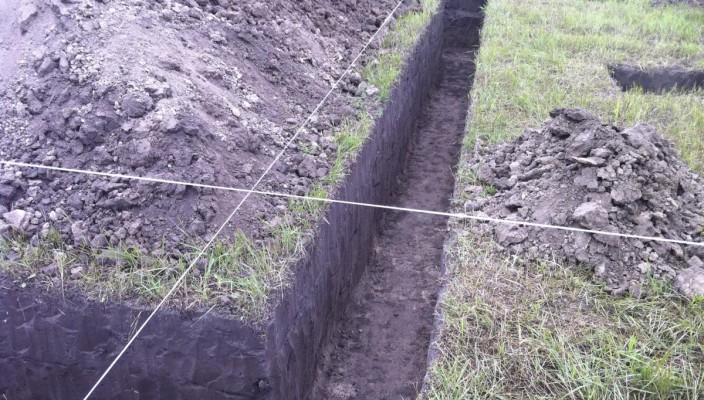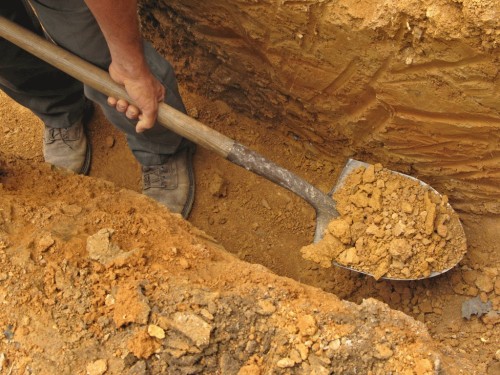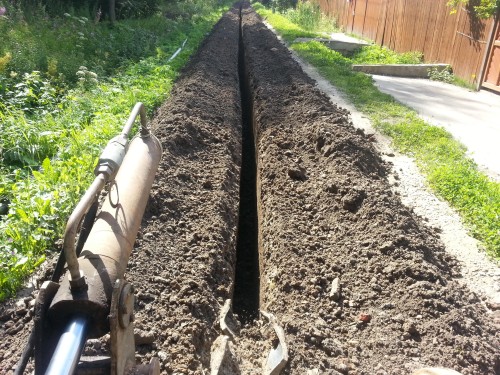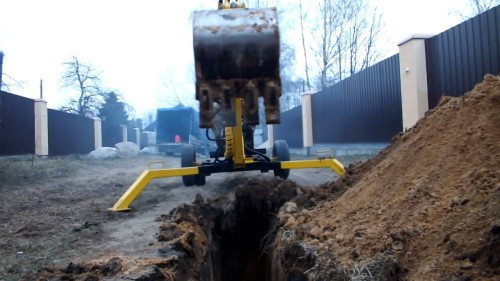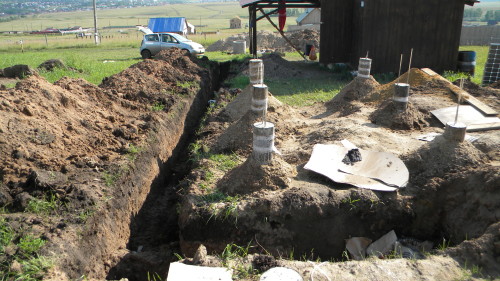In the matter of arrangement of cottages, one of the important points is considered to lay the tap pipe. But, before proceeding to this stage, you need to drench the trench for it. Some prefer to entrust this work to professionals on earthworks, others make their own entire work from beginning to end.
Content
Trench under water pipe
To dig a trench for the pipe on your own, you will need time, small skills when carrying out earthworks and a clear step-by-step instruction of the procedure. It is enough to carefully examine the question, and then simply make a conceived.
- During work, it is important to take into account some important details, such as:
- depth and width of the RVA should have a sufficient size for laying the pipe;
- so that everything is possible as best as possible, it is important to prepare all the necessary materials, pick up the section form;
- we will not give attention to calculations and planning.
- The planning and creation of the RVA under the tap pipes independently has a number of advantages, among them allocate the following:
- savings of funds for the remuneration of employees for earthworks;
- complete confidence in the quality of work.
- In addition, there are no special flaws in this matter. The only one will need to make a lot of physical effort, thereby spent more time on the process.
Earthwork budget
- To provide services for the implementation of earthworks on the site, it is necessary to take into account a number of factors affecting the price, for example, the nature of the soil, the length and width of the water supply, as well as the method and quality of work performed.
- That is why it is possible to dig a trench for water pipe at a completely different price. If you use the services of specialists, you will have to pay a decent amount of both materials and for attracting specialists of various profiles.
- An independent work on the breakthrough of the trench will be much cheaper, but the whole load both physical and financial will fall on the owner.
Trench for water pipe: how the price is formed
- If you compare prices, then we get about the following numbers. On average, to pull out the trench by an excavator, you will need about 1 500 rubles. per m³. For the delivery of an earthmower to your site, you need to pay about 5,000 rubles.
- In addition, the total amount will have to add the cost of other services that provide workers and will be in the area from 15,000 rubles. up to 50,000 rubles. As a result, it turns out a fairly substantial budget, and this is not taking into account other consumables.
- If you do this business yourself, you can save about the next price budget:
- earthworks: 500 - 1200 rubles. per m³;
- the layout will also require costs of about 5,000 rubles. Of course, you can make a scheme yourself, but if you do not have skills, it is better not to save here.
Trench for water pipe: price per meter
- Of course, the total cost of the activities for the preparation of the place under the tap pipe will depend on the trench pattern. Professionals engaged in this profile are approximately the following prices for meter:
- with a length of up to 20 m - 750 rubles;
- if length is up to 30m - 733 rubles;
- in the case when the length is 40 m - 725r;
- length up to 50m - 700 rubles;
- for trenches with a length of 60 m - 700 rubles.
- The specified prices are used when the trench depth is up to 1.5 m. If it is less than 1 m, then the cost will be cheaper by about 20%. If there is a trench independently, all these costs decrease by 2 times. It turns out that when the trench is digging under the water pipe, the price is an order of magnitude greater than, if the same is done manually.
Copper trenches under water pipe
The whole process of preparing the RVA for water pipes on the site can be divided into several stages. You need to perform consistently, without losing any details.
Planning
- The first of them is to hold all the necessary calculations and preparation of the process of earthworks.
- At this stage, you need to think through the location of the pipe and calculate the necessary parts of the site. For convenience, you can calculate the approximate cost of the work and make a necessary amount in the construction budget in advance.
- For offline type water supply, you will not need to collect documentation for the appropriate permission. This nuance simplifies the process noticeably.
- Please note that even with complete confidence that there are no communications on the site, you still need to check this fact. Because if the process fails in the process in the process, the question of the alteration will cost much more expensive.
- In order to make sure that the purity of the soil is needed to make the request of the architectural plan of communications for the passage of all binding electrical cables, sewer system and gas pipelines. In the event of the appearance of the nuances, it is important to clarify how deeply they pass. This fact will be necessary to calculate the size of the trench of the pipe.
- When planning it is best to take into account land development for some other types of communications. In the case of laying a tap pipe on a plot that is already equipped with communications, it is important to use the generally accepted rules of construction.
- It is necessary to stick to horizontal distances from the water supply station to:
- gas pipeline - 1 m;
- sewage - 0.2 m;
- thermal networks - 1.5 m;
- power cables - 0.5 m.
- If the water supply is laid under the roads, the intersection forms an angle of 90 ° C. The size of the territory that will be subject to loads will become much smaller. This will reduce the risk of malfunctions in the future water supply system.
Selecting section
- The second stage in the earthen work on the trench for the water supply is the selection of the form of section.
- The trench can have the following sections forms:
- trapezoidal;
- rectangular;
- mixed.
- The first option does not require the creation of additional fasteners. But at the same time such a trench occupies a large enough space on the plot, so it is very convenient to work with it.
- The rectangular trench is pretty simple in the coppe, but for this type, with too much depth, will be required to fasten the vertically spaced walls. Additional time costs will go to their installation.
- The mixed type can be planned in the country area when the trench depth ends exactly around groundwater.
Selection of width
The third stage of work is a width approval.
Usually, manually digging the trenches whose width varies from 0.5 to 0.8 m. To work normally with the soil and lay the water supply, the distance between the vertical parties of the trench cannot be less than 70 cm. Otherwise it will be difficult to work quite hard.
Trench depth for water pipe
- The optimal value of the RVA parameters will depend on several factors. The first of them can be called the type and nature of the soil. In the event that it is solid and rocky, you will have to attach a little more effort at earthworks. In such a situation, it is better not to make a trench too deep, quite enough 0.5 m above the upper level of the water supply. This on the one hand will protect the pipe from loads from outside, and on the other - to save money on the water supply.
- If the water pipe will be deepened in the ground by more than 1 meter, you must additionally maintain its vertical walls. The nature of the fortification will be completely dependent on the type of soil. Basically, its depth is 1.25 m, but if the base is for the most part consisting of a dense clay layer, then this value can be increased to 2 m.
- If the plumbing passes under the roads, then from its upper part to the surface, the distance cannot be less than 60 cm.
- Another point that can affect the selection of depths, these are repair work. In case of breakdowns of various character, the plumbing should be located too deep so that it can be easily and quickly fixed. To do this, it is better to lower the pipe to the minimum depth and take into account the above-considered nuances.
- It is necessary to pay attention to climatic conditions of terrain. If the depth is too small, then the water will freeze in the winter and too warm in the summer. To determine the optimal deepening, additional calculations will be required and information. For example, such as the value of the level of primerization of the soil, which differs depending on the region.
- To the found value you need to add another 50 cm. The result of this amount and will be the most optimal depth in accordance with climatic features.
- In order not to carry out additional calculations, you can simply insulate the pipes outside. This will also make it possible to significantly reduce earthworks in time and applied efforts.
- If the value of the desired depth will exceed 1.5 m, then there will be a small technique for the trench.
- The last factor to take into account when planning is the intersection of communications. Here everything is simple, you only need to save enough distance:
- from undergoing cables and pipes - from 60 cm to 25 cm;
- over the sewer system - more than 40 cm.
Preparing for work on a trench
- As soon as the parameters are approved, and the scheme is composed, you can proceed to the preparation of the rigging of the trench.
- The territory assigned to the pipeline must be fully cleaned from trees, shrubs and various garbage. For this, the primer needs to prepare in advance: eliminate all the vegetation and clean the garbage.
- If electrical instruments are required, then you need to think over the power supply. This will help prevent the occurrence of some problems already in the process.
- Take care of the presence of a room for the location of the soil, which will be extracted. Not always on the outskirts of the trench it is enough. It may be necessary to export a wheelbarrow of a number of echoed land.
- If you need to have boards ready to create bridges on one side of the trench on the second.
Selection of tools
- Before starting work, you need to prepare the necessary materials. For trenches, we will need:
- rope;
- plumb;
- hammer;
- pick;
- bayonet shovel;
- axe;
- level;
- roulette;
- soviet shovel;
- stakes;
- boards, slopes for fasteners;
- gloves;
- pencil;
- protective clothing;
- glasses;
- wheelbarrow;
- hacksaw.
Marking
A scheme drawn on paper needs to be placed on the earthlings, which is assigned to the trench. The line of the top of the RVA should be drawn with the help of stakes and rope. In this case, the hammer and roulette will be needed. The markup does not occupy a lot of time, since the procedure does not require a clear accuracy of measurements.
Copper trench for water pipe: Method 1
After completion of all preparation steps, you can proceed to the breakthrough of the trench. It is desirable during work to clearly follow the recommendations and plan of work.
- Measurement tools should be used regularly to reduce work and applied efforts.
- Consider that the volume of the extracted soil will be more released space. Therefore, you need to take care of the possibility of its export.
- During the seizure of the soil, it is necessary to do it in such a way that the earth does not fall back into the trench. Otherwise, it will be spent a lot of time.
- If the upper part of the soil is fertile, then it is better to save it. It may be needed in gardening for planting plants.
- Drain trench must be carried out by layers. First, the first layer is cut off and bursts with a bayonet shovel. Next, the rest is still digging up to the desired depth.
- As soon as the trench is dug, it must be prepared for laying the pipe. For this:
- the bottom must be well to dissolve;
- it is necessary to place a sandy layer with a height of 20 cm;
- if necessary, the foundation can cut the desired hole with the perforator;
- in the event that the pipe is supplied to the well or well, you will need a hole that will allow you to connect with a watering tube with a water supply;
- if the connection is carried out to the highway, the previous item can be omitted.
Copper trench for water supply: method 2
There is another fairly original way that can be used to dig a trench. They can take advantage of those who have no time to do with shovels. It allows you to dig a trench in a more compressed duration.
Preparation Before starting work is carried out in the same method as in the first case, there will be no additional nuances here. Consider the sequence of work.
- Burning drums along the future trench with a diameter of about 15 cm. The distance between them should reach up to 5 m.
- During drilling, it is necessary to fill the wells with water.
- Then they need to lower the tanks from the metal with the cutouts of the longitudinal shape. Their width should be about the same as the trench, but to form a smaller diameter than wells.
- If the soil is sandy, then a 5-meter trench with a width of 10 cm for this technique will be ready after 30 minutes, and its depth will be no more than 80 cm.
- The drilling of wells will be required about the same amount of time.
- This method is perfect for digging a trench for a plumbing, but the time will take a little less. Perhaps it will be possible to meet 1 day, whereas when working with shovels may need several days.
It is not so easy to escape the trench for the water supply, but from a technological point of view it is not at all difficult if you consider all the necessary nuances and clearly not to move away from step-by-step instructions. Of course, you will need to make a little physical effort and be patient.

